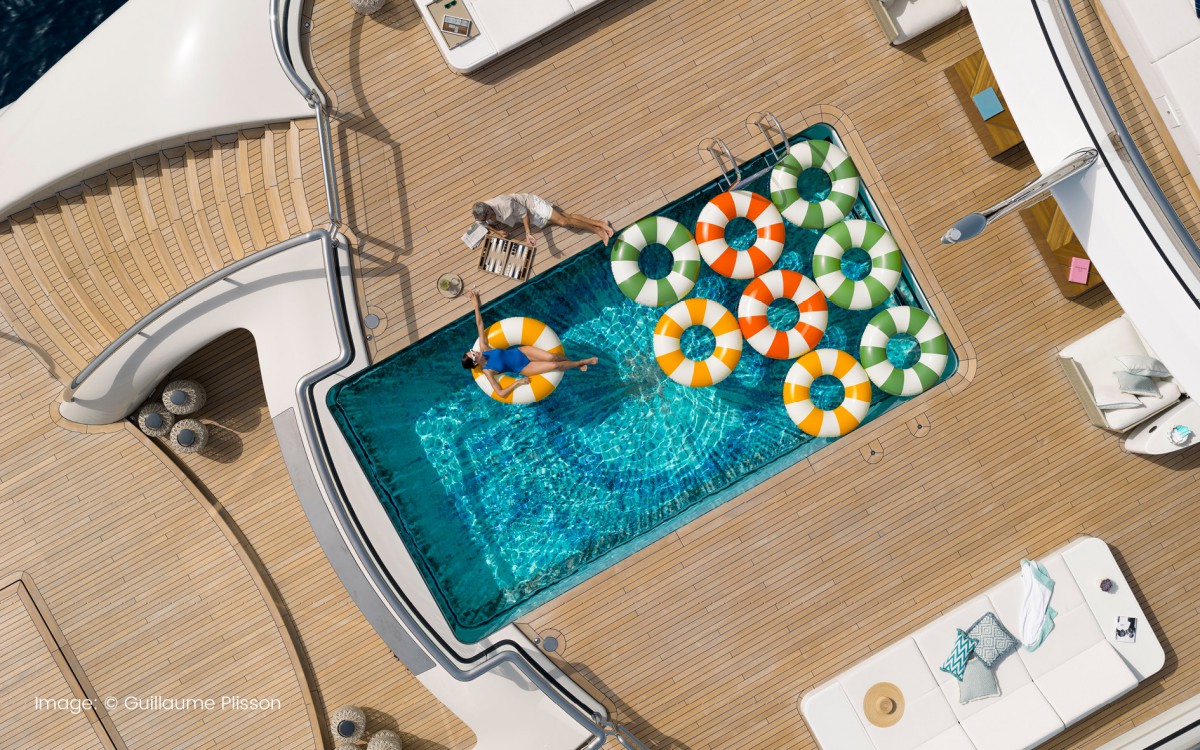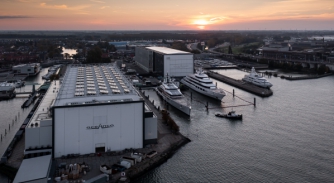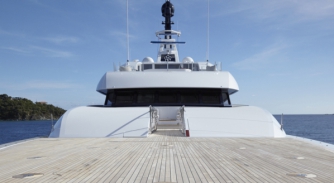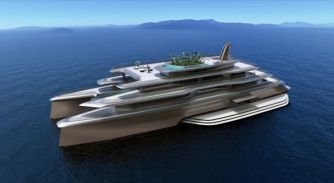Oceanco – going against the grain
From laminated plantation wood to cork and solar-integrated surfaces, the Dutch yard is redefining the boundaries of what decking can be …
As part of News Editor Conor Feasey’s deep dive into the thorny topic of teak, he spoke with Feadship, Lürssen and Oceanco to explore their cutting-edge approaches to long-term sustainable teak alternatives.
Their responses are being published in three parts – here is the third; the first and second have already been published.

The teak deck on 105.26-metre H3, built by Oceanco and delivered in 2000.
Around five years ago, Oceanco began researching teak alternatives exten-sively. Even before legislation started to shift, there was a sense that irreversible change was on the horizon. Sourcing teak was already becoming increasingly complex and the adage ‘If you can get it, you can use it’ was starting to unravel fast. As one of the largest builders by average LOA, the Dutch shipyard’s scope is vast, with its integrated teams covering more than just decking but also everything from interiors, exterior furniture, ceilings and all other related elements. So naturally, teak has been central to the company’s offering for an eternity. And change, real, meaningful change, takes time, especially considering the calibre of owners operating in this segment of the market.
To gain insight into what they are seeing from their eagle-eyed view of the highest end of industry, I sit down with Alan Coleman, Head of Interior Design and Outfitting, and Wim Verhoeff, Head of Sales. The pair explains that they were aware of issues looming in the background surrounding teak, even though it was still technically legal to source at the time. “The biggest issue we face is that we’re now trying to replace a beautiful, natural material that in many ways is still the perfect non-slip deck surface. Every alternative feels like a compromise. And so, for real progress, we’re talking about a seismic shift in thinking across the industry,” explains Coleman.
There’s been a slow movement away from teak, simply because people have relied on it for so long. Now the likes of Coleman are being forced to look at alternatives. However, each of these comes with its own caveats: how they’re used, maintained, installed and even how they perform over time. Decking is, of course, the most visible place teak is used, so it’s where most people associate the material.
But it goes beyond that. Teak has been used in cladding, interior elements and even structural features. Across shipbuilding as a whole, it’s still seen as synonymous with luxury. “For a lot of people, a yacht should look like a yacht and teak is seen as central to that identity,” adds Verhoeff. “So the resistance isn’t just practical, it’s perceptual. But the shift is underway, affecting both maintenance and operational considerations as well as aesthetics. It just hasn’t fully landed and there’s still a long way to go to roll it out to the next level.”
At first, when Verhoeff and Coleman proposed alternatives to teak, people weren’t receptive at all. In fact, they had to fight to strengthen their position. At Oceanco, they no longer support specific sourcing routes because they reject operating in grey areas. However, once clients were presented with credible scientific data and real alternatives, the idea began to gain traction. “Most of the lab research we’ve done was initially aimed at finding a natural alternative to teak,” explains Verhoeff. “But teak has almost magical material properties in terms of its natural acidity, oil content and internal structure. It all plays a part and it’s uniquely well-suited to marine environments. So getting a natural alternative with those properties, well, that’s quite tricky.”
You are still seeing both ends of the spectrum. Some clients prefer the traditional approach of using teak first and if that’s not possible, then the closest visual match. “But others want to go radical, embrace change and explore completely new design directions for decking. We’re seeing clients go all the way in the other direction, saying, “If I can’t have teak, then I don’t even want it to look like teak.” Colours, patterns and entirely different materials are being used by a growing number of owners and it is causing the old aesthetic codes to loosen.
The biggest hurdle remains the industry’s risk aversion, especially at this level. On 100-metre-plus projects, the stakes are as high as the price tag and if something goes wrong with the deck, it’s a major expense to fix.
That freedom has allowed Oceanco to test an unusually broad range of alternatives, with the team trialling everything from maple, bamboo and cork to heat-treated woods, chemically modified timbers and other composites. However, teak’s unique material pro-perties remain difficult to replicate. The reality is that the closest alternative to teak decking is still teak itself, but plantation-grown teak has been one of the most scrutinised options. The faster growth cycles, typically around 30 years compared to centuries-old Burmese trees, produce smaller trunks, which makes it harder to source the stable, high-quality stock required for decking.
“The issue with teak decking is that it requires quarter-sawn timber, the part of the log where the annual growth rings are at a 90-degree angle to the plank face,” says Coleman. “That cut is preferred because it moves the least when exposed to wet and dry conditions and since it’s being used outdoors, stability is critical. But quarter-sawing is also inefficient. It produces a lot of waste and irregular offcuts that aren’t suitable for decking. With plantation teak, the smaller trees make it even harder to extract enough clean quarter-sawn stock. So, if you try to use it as-is, you often end up compromising on the look, inconsistent grain, unusual features, visual variation that could lead to issues down the line.”
This is where lamination becomes a solution. Coleman explains that by taking teak planks, typically in thin 1mm strips and laminating them under pressure, you bypass the limitations of the raw cut teak and instead of relying on large sections of pure quarter-sawn wood, you engineer the plank from multiple thin stable layers. The result is a material that performs like traditional teak while delivering far better yield from smaller plantation logs. Sourced from FSC-certified forests in Thailand, these laminated planks can now be produced in lengths up to four metres, which is a significant breakthrough considering that available lengths were dropping year on year. And so far, laminated plantation teak has performed well in testing, both visually and structurally.
“Beyond teak itself, Oceanco has broadened its testing programme to include other natural and engineered materials. The team has also trialled marine maple, which has shown surprisingly strong results and is now planning more extensive real-world evaluations. Bamboo, however, presented challenges with expansion and contraction, and Accoya, a heat-treated maple and acid-treated pine, failed to match the performance of traditional teak under Oceanco’s simulations. Synthetic and composite options, on the other hand, introduce a different trade-off. Because they’re chemically engineered, their material properties can be tightly controlled, allowing for high durability and consistency. But they come with higher carbon footprints during production and resistance remains strong at the client level, partly due to lingering perceptions of ‘fake teak’ and partly because if something goes wrong on a 100-metre yacht, the cost to rectify it is enormous.
This is why cork sits somewhere between synthetics and laminated teak. Its appeal lies in its sustainability credentials; it’s carbon-negative, fully recyclable and harvested without felling trees, but its perception lags behind its performance. “It has a bad perception in yachting circles because it’s associated with small boats. But it’s actually a lovely material underfoot – very tactile. No, it doesn’t have the same performance properties as teak, but it’s absolutely worth exploring,” says Coleman.
“The challenge is that using cork means stepping into a different decking system entirely. For years, the industry has defaulted to teak. We’ve built systems, maintenance routines and design expectations around it. Switching from that is difficult, but with regulation forcing people’s hands, we could see a shift in conversation there too. Of course, cork can lose its colour over time, but there are UV coatings to help preserve it. It can be sanded and it’s already being used by some progressive architects for cladding on buildings, including one we know of in Oxfordshire. And if it can survive an English winter on a façade, it deserves a serious look on board.”
Beyond teak itself, Oceanco has broadened its testing programme to include other natural and engineered materials. The team has also trialled marine maple, which has shown surprisingly strong results and is now planning more extensive real-world evaluations.
For all the R&D breakthroughs, the real challenge has always been mindset over materials. The biggest hurdle remains the industry’s risk aversion, especially at this level. On 100-metre-plus projects, the stakes are as high as the price tag and if something goes wrong with the deck, it’s a major expense to fix. Much of that reluctance doesn’t always come directly from the owner but from their team whose job is to safeguard against risk. The caution is understandable, but it slows adoption. Oceanco has conducted extensive due diligence on multiple materials, running tests, validating sourcing and making clear recom-mendations. Still, as Coleman points out, lab conditions can only go so far. Until these alternatives spend five years in the Caribbean or the Med, nobody will truly know how they perform in the real world.
“At the end of the day, as an industry, we need to do a better job of training crew and managing owner expectations. Every material comes with a maintenance profile. The goal is to preserve it, not wear it out. Sanding a teak deck every month doesn’t make sense either. It’s a living material and we need to treat it that way,” says Verhoeff. “Of course, every shipyard strives to be a pioneer in innovation. So, when it comes to sustainable R&D, we’re more than happy to share what we learn. That includes our suppliers too. We actively encourage them: read the reports, learn from the results. If we want to exist long term as an industry, we need to move together. We have the resources to research and develop and when we do, we should be generous with that knowledge.”
And sometimes you need owners who are genuinely willing to innovate and push the boundaries for this to happen. Verhoeff recalls Black Pearl, where Oceanco developed energy regeneration systems for the sails – technology now being adapted across other industries. That’s the kind of ripple effect the industry needs to see with decking too. If viable solutions can be proven and then shared, everyone benefits. Right now, laminated teak is looking strong. Conversations at the coalface with installers confirm they’re pleased with how it handles and performs in practice. “We’re just completing our first project using it and it’s due to launch this year,” says Coleman. “It’s the first time we’ve applied this material at full scale and so far, the results have been excellent. The installation process has gone smoothly and visually, it looks better than most of the teak decks we’ve delivered in the last decade. That said, time will tell. The real test is how it performs.”
Where real change begins, there’s always pushback. Oceanco has approached this with education from the start. Simply telling an owner building their dream yacht that ‘teak is bad’ seldom works. You have to bring them into the process, explain why alternatives are being used, show them results and unpack the science. That takes time and these lessons will need years to truly take hold. We are witnessing ongoing seismic shifts in research, however. New products are emerging, including a British company developing a solar panel with a teak-look foil on top. “It does impact the efficiency slightly, but only marginally. And when you consider the sheer surface area on large yachts, particularly in less-trafficked zones, it could become a major energy contributor,” says Coleman. “Think of the flat surfaces on a yacht exposed to Caribbean or Mediterranean sun. Those square metres could become part of the energy system. That’s a real opportunity and we’re watching it closely.”
“We need to see this moment for what it is. It’s not just a challenge, but an opportunity,” adds Verhoeff. “New companies are entering the space and new functions for decking are being explored. Honestly, I hope that 50 years from now, we look back at teak and ask ourselves, ‘What were we thinking, always putting wood out there?’ Now, we understand that ‘sustainable superyacht’ is a contradiction in terms. A yacht, by
definition, isn’t sustainable. But what we can do is act as a catalyst for sustainable innovation. That’s where our focus is. Everything we do is guided by eco-conscious thinking and wherever possible, we push to develop something better, something that moves the conversation forward.”
At yards like Oceanco, responsibility weighs heavily, largely due to the visibility and calibre of what they build. Their projects are high-profile and when a material choice is made, it has ripple effects across the market. If they use marine cork, laminated teak or another boundary-pushing alternative, it gives others the confidence to follow. It normalises the choice. And maybe that’s the next big step, not full replacement, but a combination.
“We’re already starting to think that way,” Coleman concludes. “Perhaps in the owner’s area, you still use the most premium, traditional product, because that’s where aesthetics and feel matter most. However, elsewhere in service areas, technical zones, sundecks and helipads, you might use materials like cork or a composite. The key is making sure it’s cohesive. If the materials are harmonised, if the colour and finish work together, clients may not even notice the difference. That blended approach might be how we make meaningful progress at scale.”
What we’re seeing across Feadship, Lürssen and Oceanco isn’t a flash-in-the-pan trend, it’s the result of tens of thousands of hours of research, millions of euross pent, all amid ethics and expectations shifting as rapidly as the environment around us. We are witnessing a funda-mental change in the market in real time, coinciding with a realignment in mindset among owners at the very top. These are the builders who shape industry norms, technical, visual and cultural influence. And when that top tier begins investing in alternatives, educating owners, chal-lenging suppliers, and installing next-gen decking at real scale, it sends a message downstream.
Forget about greenwashing. What’s being developed is as much a response to supply and performance as it is to sustain-ability, perhaps more so. A resource that was once synonymous with the definition of a yacht has become too problematic to consider a genuine future with. And from the laminated plantation teak engineered for stability or Tesumo’s proprietary thermal-resin modification to Feadship’s multi-material benchmarking and life-cycle impact modelling, this is deep technical R&D, not just aesthetic or sustain-able substitution.
What’s more, these projects are not confined to design studios or renderings. They’re being installed on 100-metre-plus builds and tested on helipads, sundecks and technical areas. They are already underfoot, in salt, sun and spray. Tangible evidence of how the market is evolving. Of course, as with anything that happens in yachting, it is slow and marked with trepidation, but the old teak mindset is beginning to loosen.
And when these builders, with the clients who can afford anything, begin shifting toward materials that are more traceable, more scalable and more sustainable, the trickle-down effect becomes inevitable. The question isn’t whether we’ll see these technologies enter serial production yards and sub-500gt builds at scale. The question is when – and who’s ready.
This article first appeared in The Superyacht Report – Owners Focus. With our open-source policy, it is available to all by following this link, so read and download the latest issue and any of our previous issues in our library.
Profile links
NEW: Sign up for SuperyachtNewsweek!
Get the latest weekly news, in-depth reports, intelligence, and strategic insights, delivered directly from The Superyacht Group's editors and market analysts.
Stay at the forefront of the superyacht industry with SuperyachtNewsweek
Click here to become part of The Superyacht Group community, and join us in our mission to make this industry accessible to all, and prosperous for the long-term. We are offering access to the superyacht industry’s most comprehensive and longstanding archive of business-critical information, as well as a comprehensive, real-time superyacht fleet database, for just £10 per month, because we are One Industry with One Mission. Sign up here.
Related news

The Superyacht Report 226: Owners Focus – out now!
From Oceanco, the PYA to MYBA, read the inside stories of the leaders shaping the future of yachting. Read TSR 226: Owners Focus today
Opinion

Transfer of ownership – the future of Oceanco
A brief history of the shipyard and what the future may hold under its new owner
Business

Deck to the future!
A deep dive into the drive to replace the endangered-teak supply chain with upcoming deck materials that are fast becoming the sustainable replacement options
Fleet

Building above and beyond
Oceanco’s yachts are iconic for a reason. But now the Dutch giant is pushing its shipbuilding abilities to new heights through its range of custom build s
Fleet
Related news
The Superyacht Report 226: Owners Focus – out now!
3 months ago
Transfer of ownership – the future of Oceanco
4 months ago
Deck to the future!
4 months ago
Building above and beyond
1 year ago
NEW: Sign up for
SuperyachtNewsweek!
Get the latest weekly news, in-depth reports, intelligence, and strategic insights, delivered directly from The Superyacht Group's editors and market analysts.
Stay at the forefront of the superyacht industry with SuperyachtNewsweek



